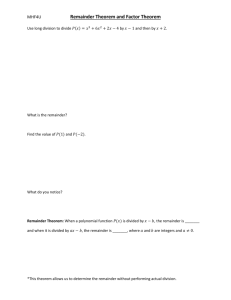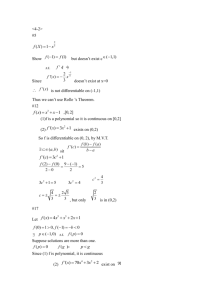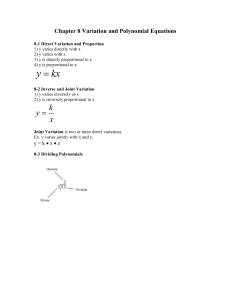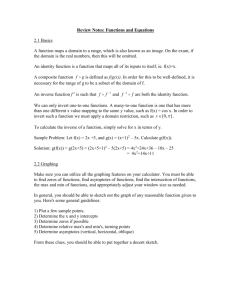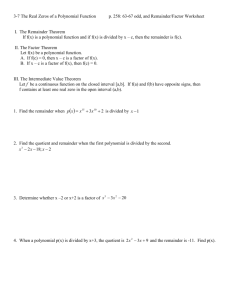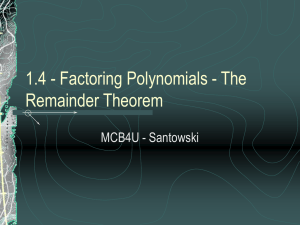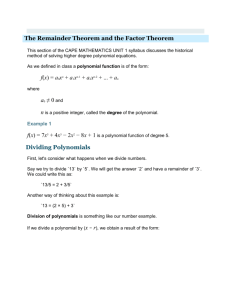factorth - Leaving Cert Solutions
advertisement
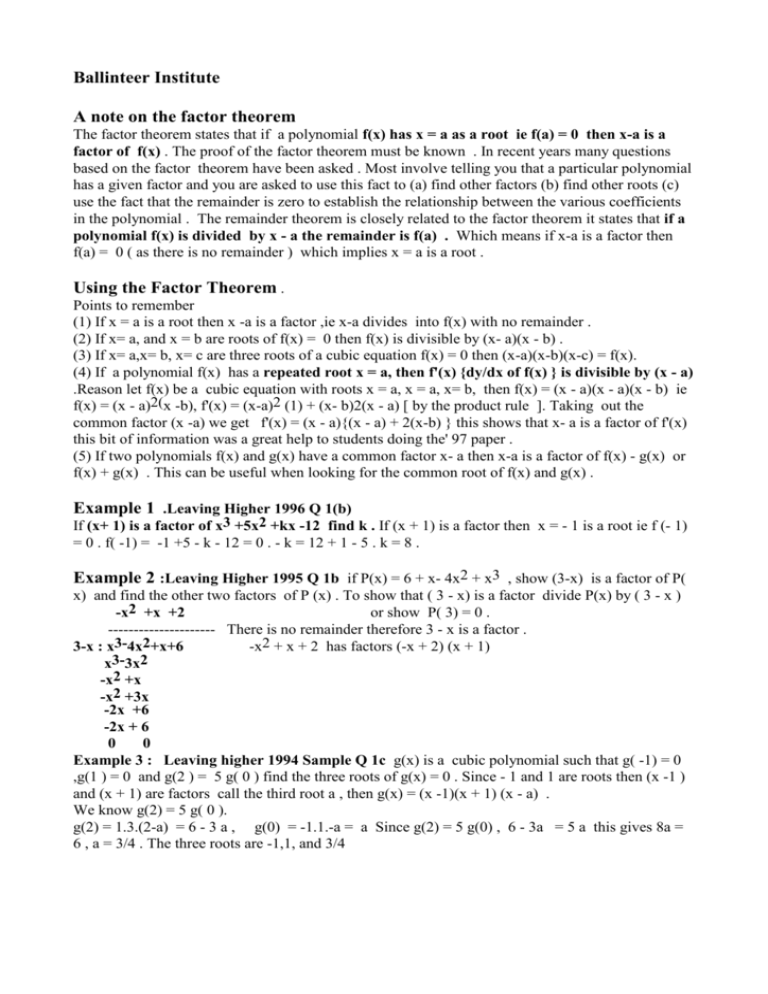
Ballinteer Institute
A note on the factor theorem
The factor theorem states that if a polynomial f(x) has x = a as a root ie f(a) = 0 then x-a is a
factor of f(x) . The proof of the factor theorem must be known . In recent years many questions
based on the factor theorem have been asked . Most involve telling you that a particular polynomial
has a given factor and you are asked to use this fact to (a) find other factors (b) find other roots (c)
use the fact that the remainder is zero to establish the relationship between the various coefficients
in the polynomial . The remainder theorem is closely related to the factor theorem it states that if a
polynomial f(x) is divided by x - a the remainder is f(a) . Which means if x-a is a factor then
f(a) = 0 ( as there is no remainder ) which implies x = a is a root .
Using the Factor Theorem .
Points to remember
(1) If x = a is a root then x -a is a factor ,ie x-a divides into f(x) with no remainder .
(2) If x= a, and x = b are roots of f(x) = 0 then f(x) is divisible by (x- a)(x - b) .
(3) If x= a,x= b, x= c are three roots of a cubic equation f(x) = 0 then (x-a)(x-b)(x-c) = f(x).
(4) If a polynomial f(x) has a repeated root x = a, then f'(x) {dy/dx of f(x) } is divisible by (x - a)
.Reason let f(x) be a cubic equation with roots x = a, x = a, x= b, then f(x) = (x - a)(x - a)(x - b) ie
f(x) = (x - a)2(x -b), f'(x) = (x-a)2 (1) + (x- b)2(x - a) [ by the product rule ]. Taking out the
common factor (x -a) we get f'(x) = (x - a){(x - a) + 2(x-b) } this shows that x- a is a factor of f'(x)
this bit of information was a great help to students doing the' 97 paper .
(5) If two polynomials f(x) and g(x) have a common factor x- a then x-a is a factor of f(x) - g(x) or
f(x) + g(x) . This can be useful when looking for the common root of f(x) and g(x) .
Example 1 .Leaving Higher 1996 Q 1(b)
If (x+ 1) is a factor of x3 +5x2 +kx -12 find k . If (x + 1) is a factor then x = - 1 is a root ie f (- 1)
= 0 . f( -1) = -1 +5 - k - 12 = 0 . - k = 12 + 1 - 5 . k = 8 .
Example 2 :Leaving Higher 1995 Q 1b if P(x) = 6 + x- 4x2 + x3 , show (3-x) is a factor of P(
x) and find the other two factors of P (x) . To show that ( 3 - x) is a factor divide P(x) by ( 3 - x )
-x2 +x +2
or show P( 3) = 0 .
--------------------- There is no remainder therefore 3 - x is a factor .
3-x : x3-4x2+x+6
-x2 + x + 2 has factors (-x + 2) (x + 1)
32
x 3x
-x2 +x
-x2 +3x
-2x +6
-2x + 6
0
0
Example 3 : Leaving higher 1994 Sample Q 1c g(x) is a cubic polynomial such that g( -1) = 0
,g(1 ) = 0 and g(2 ) = 5 g( 0 ) find the three roots of g(x) = 0 . Since - 1 and 1 are roots then (x -1 )
and (x + 1) are factors call the third root a , then g(x) = (x -1)(x + 1) (x - a) .
We know g(2) = 5 g( 0 ).
g(2) = 1.3.(2-a) = 6 - 3 a , g(0) = -1.1.-a = a Since g(2) = 5 g(0) , 6 - 3a = 5 a this gives 8a =
6 , a = 3/4 . The three roots are -1,1, and 3/4
Example 4 Leaving Higher 1997 Q 1 c . If (x - 1) 2 is a factor of ax3 +bx2 + 1 find the value of a
and the value of b . Since ( x - 1) 2 is a factor then x = 1 is a root this means f (1) = 0 .
ie a + b + 1 = 0 . Since ( x - 1) 2 is a factor then x = 1 is a root of f '(x) = 0 . f '(x) = 3ax2 + 2bx .
f'(1) = 0 , 3a + 2b = 0 . Now find a and b
a + b = - 1 .Muliply by -2
3a + 2b = 0
-2a -2b = 2
3a + 2b = 0 a 2, b 3
Example 5 Leaving Higher 1994 Q 1c ; If x2 + ax + b is a factor of the polynomial x3 + px2 + rx
+ s . Prove that r - b = a (q - a) and s = b(q - a) . Since x2 + ax + b is a factor then ther is no
remainder when x3 + px2 + rx + s is divided by x2 + ax + b .
Hence r - b = a( q - a) and s = b ( q - a)
x (q a)
x ax b x qx rx s
2
3
2
x 3 ax 2 bx
x 2 (q a ) x( r b) s
x 2 ( q a ) xa ( q a ) b ( q a )
Example 6 Leaving Higher 1989 Q 2c . find the values of b for which the two equations
x3 + x2 -bx -b2 and x3 + 5x2 +2bx -2b2 = 0 have a common root other than x = 0 .Set the two
equations equal to each other and simplify .
x 3 x 2 bx b 2 x 3 5 x 2 2 bx 2 b 2 4 x 2 3 bx b 2 0 ( 4 x b )( x b ) 0
x b , x 4b ,
Now sub in the values of x into one of the equations When x = - b we get- b3 + b2 +b2 - b2 = 0.
2
This gives- b3 + b2 = 0 b ( b 1) 0 b 1, b 0 Now sub in b/4 we
3
2
b b
b
b b 2 0. b 3 4b 2 16b 2 64b 2 0. b 3 76b 2 0.
get 4 4
Since b = 0 is
4
b 0, b 76.
inadmissable then b = 1 and b= 76 are the two values of b for which the equations have a common
root . An unusual question the solution is based on the fact that if x = a is the common root of F(x)
= 0 and G (x) = 0 . Then x = a is a root of F(x) - G(x) = 0 .
1
1
9
9 find all t and all the solutions of g(x)
4 x 3 tx 2 28 x 28
= 0 . x = -1 is a root ,sub in x = - 1 to get the value of t 1 1 9 9 0 t 4 .The
4 t 28 28
Example 7 If x + 1 is a factor of
1
1
9
9
1 1 9 1
2
0. 2 1 1 0
3
4x
4x
28 x 28
4 x x 28 x
equation becomes
9
7
1 1
2
1 2 0. x 1, 36 x 28, x
28
3
x 4 x
